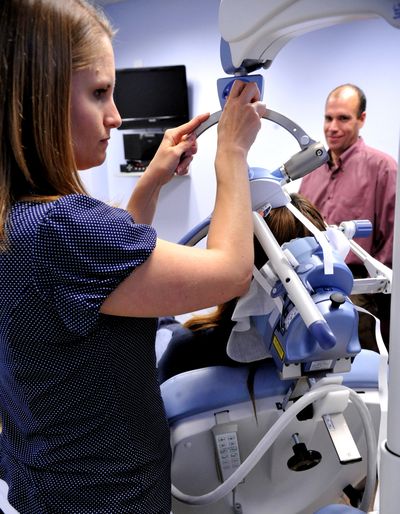Uplifting therapy
Magnetic stimulation being used on depression

CORVALLIS, Ore. – There’s a new weapon in the fight against depression, and while it’s not for everyone, it may help some patients who aren’t responding to other treatments.
It’s called transcranial magnetic stimulation – TMS for short – and it uses targeted magnetic pulses to generate electrical activity in a region of the brain believed to be linked to depression.
“The ideal candidate is someone who has tried an antidepressant and either they couldn’t stand the side effects or they didn’t get better from one or two (drugs),” said Dr. Scott Babe, a psychiatrist who is pioneering the treatment at Samaritan Regional Mental Health Center in Corvallis.
“I will talk to my patients about it because a lot of medications people take for depression have some pretty significant side effects.”
The first commercial device for TMS therapy, called the NeuroStar, was cleared by the U.S. Food and Drug Administration in 2008 for the treatment of major depressive disorder. A little over 300 have been installed in hospitals and clinics around the country, but so far Samaritan has the only one in Oregon.
Samaritan installed its $75,000 TSM unit in August and began treating patients in September. About 10 people have gone through the treatment in Corvallis.
The NeuroStar equipment looks a little like something you might see in a dentist’s office, with a reclining chair for the patient and a swing arm that holds the business end of the device, a powerful magnetic coil.
A typical course of treatment involves four to six weeks of daily TMS sessions. The first session, in which the positioning of the coil and minimum effective magnetic level are dialed in for the patient’s individual needs, takes about 90 minutes, with subsequent sessions taking about an hour each.
A technician positions the coil against the patient’s head and adjusts the device to deliver a measured level of magnetic stimulation to the cerebral cortex. The coil delivers a series of rapid magnetic pulses – 40 per minute – for 37 minutes.
The alternating magnetic pulses generate a weak electric current in the brain, causing neurons to fire. Although the precise therapeutic mechanism is not well understood, a government-funded study published in 2009 found that 14 percent of patients went into remission after three to five weeks of TMS treatment. In a second, less restrictive phase of the test, remission numbers jumped to 30 percent.
“It’s focused on the left prefrontal cortex, which seems to be inappropriately active or inactive in patients with depression,” said Dr. Paul Holtzheimer, an assistant professor of psychiatry at Emory University School of medicine in Atlanta. Holtzheimer was one of the investigators in the National Institute of Mental Health study and took part in two clinical TMS trials funded by Neuronetics, the company that makes the NeuroStar device.
TMS is not nearly as effective in treating depression as electroconvulsive therapy – sometimes known as shock treatment – which uses electricity to induce seizures that can recalibrate brain function in some patients, Holtzheimer said. But it has far fewer and less-severe side effects.
“For patients who don’t tolerate medication, it’s probably a very good option,” he said. “I think it definitely has a place in treatment.”
There are also studies under way into other potential uses for transcranial magnetic stimulation, including treatments for post-traumatic stress, obsessive-compulsive disorder and addiction. While those results have been less promising so far, Holtzheimer thinks research may eventually lead to other beneficial applications.
“I think the basic premise – that you can stimulate various regions of the brain involved in a disorder – is valid,” he said. “It’s just a question of where you stimulate.”
Unlike electroconvulsive therapy, TMS is an outpatient treatment. No anesthesia is required, and patients can resume normal activity immediately after a session.